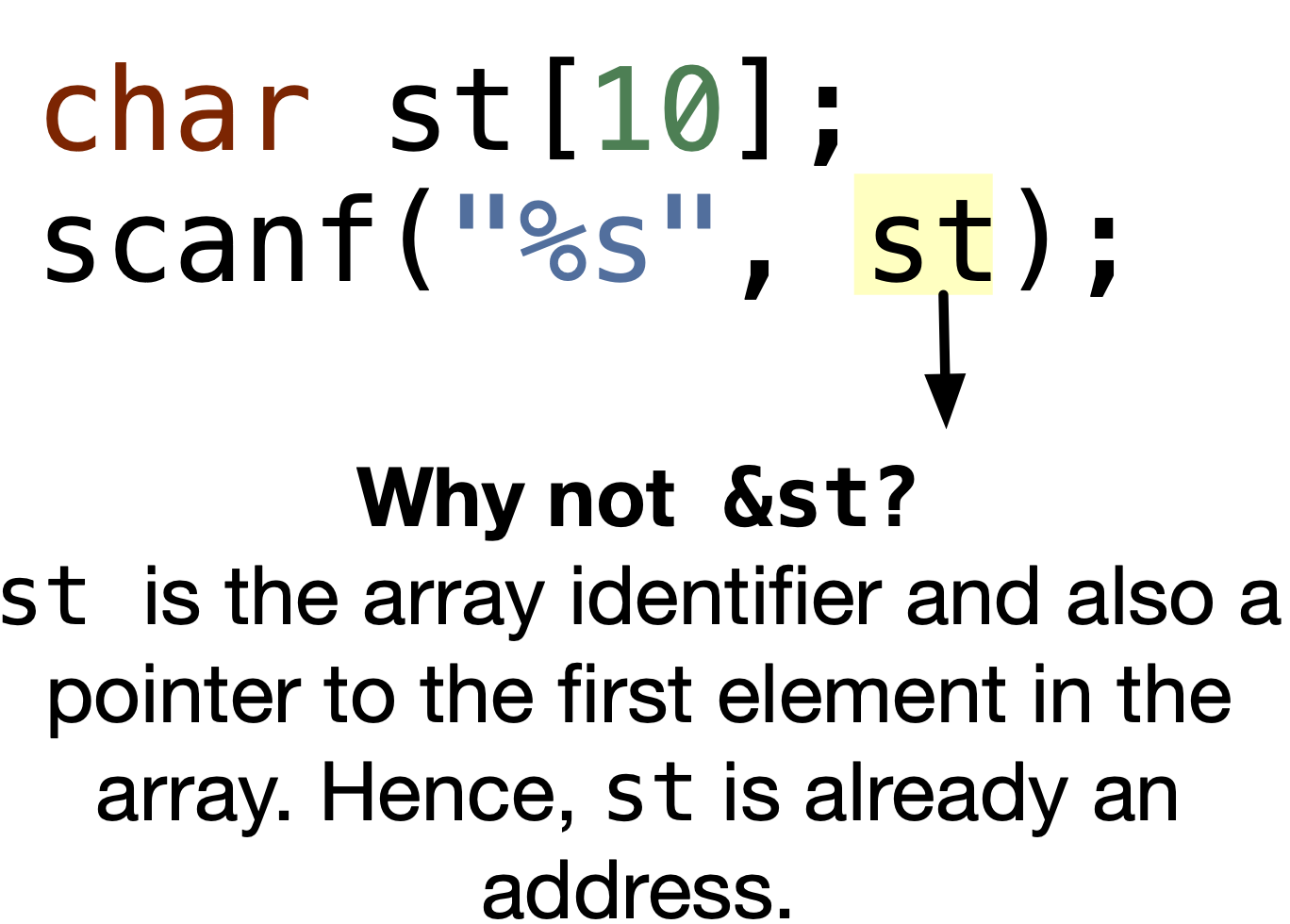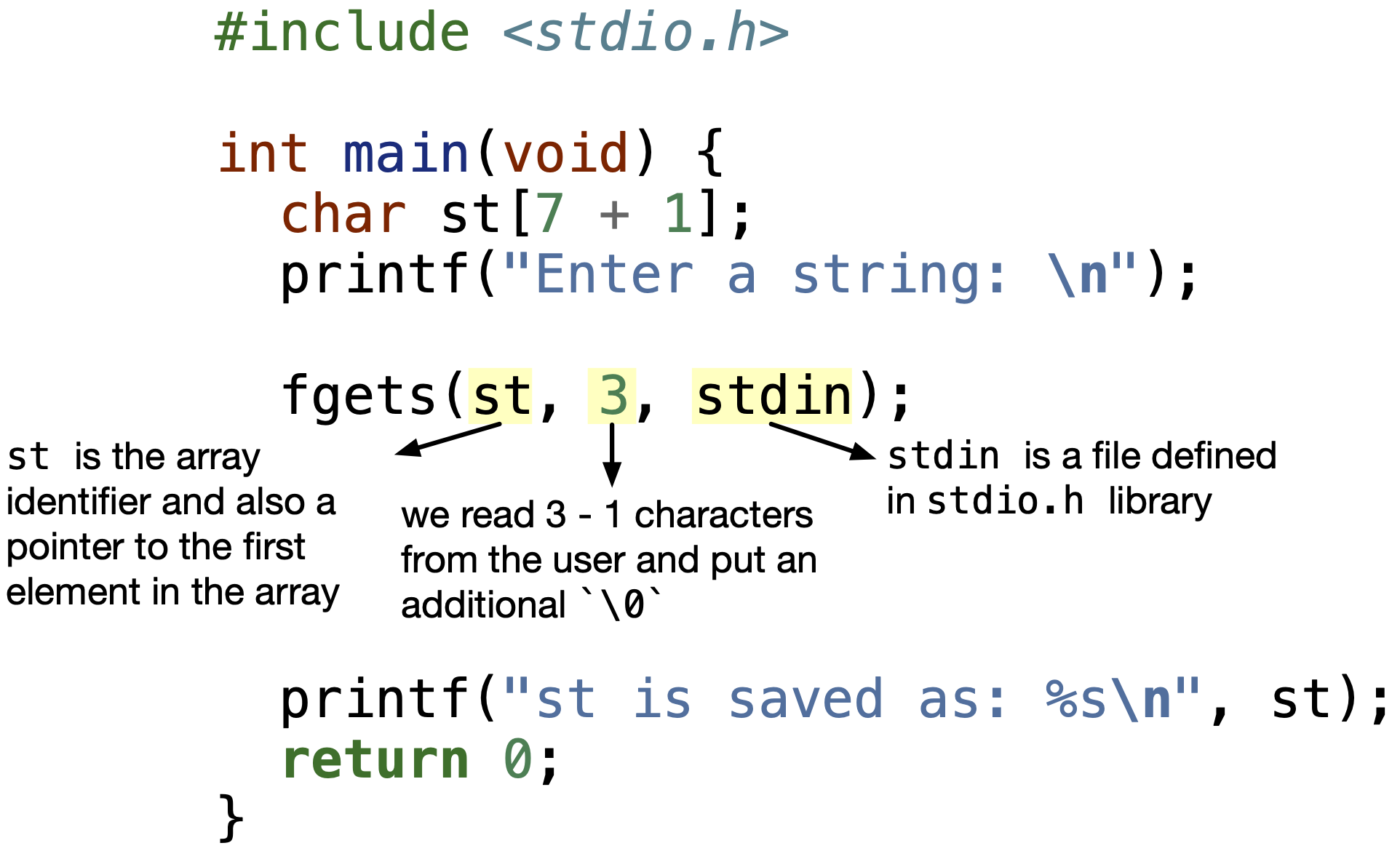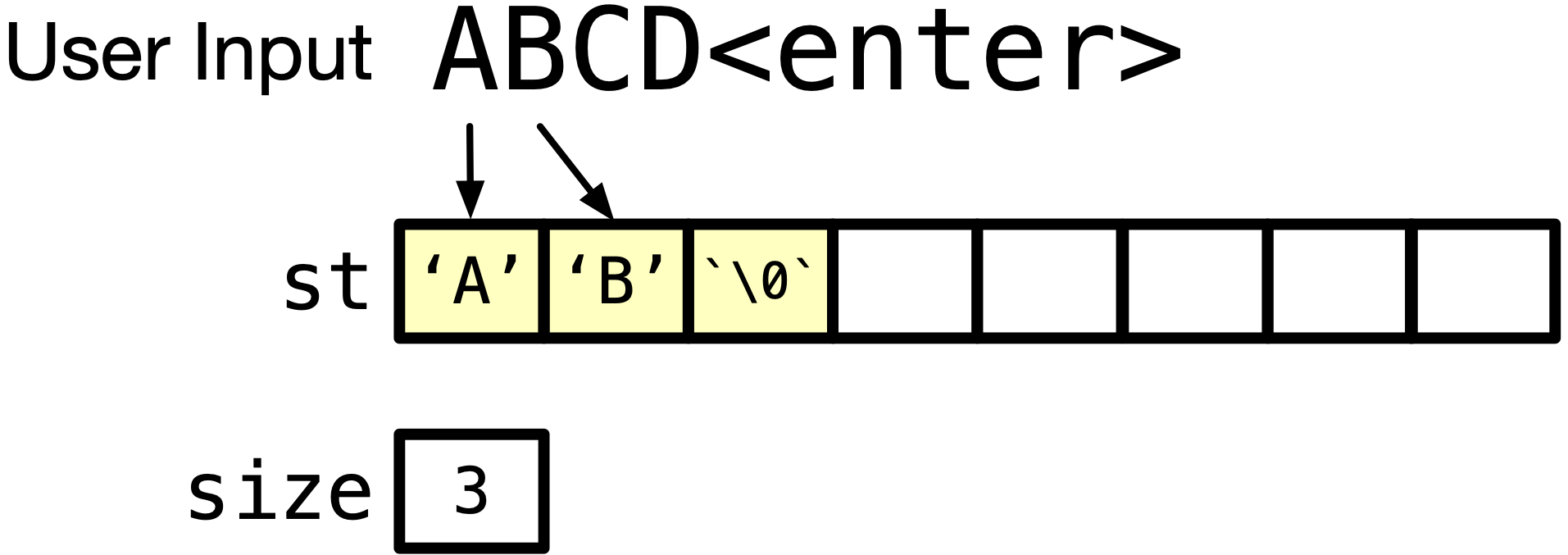Input/Output Strings
Contents
10.2. Input/Output Strings#
10.2.1. Output strings#
10.2.1.1. Using printf#
To be able to print a string to the user, we use printf. However, there are some considerations, we have to keep in mind. For example, in the following figure, we are printing a null-terminated array of characters — a string. printf uses %s format specifier, and it requires a pointer to the first character in the array. It will print from str[0] till (and not including) the first null character '\0'.

Printing happens from the first character pointed to by the pointer. This means that if we pass a pointer to the middle of the string, it will print the rest of the string. For example, if we pass str + 2 to printf, it will print llo.
Code
#include <stdio.h>
int main(void) { char s[] = "Hello"; printf("%s\n", s + 2); return 0; }
If we want to print a particular number of characters, we can use the %.*s format specifier and replace * by the number of characters to print. For example, if we want to print the first two characters of the string, we can use the following code.
Code
#include <stdio.h>
int main(void) { char s[] = "Hello"; printf("%.2s\n", s); return 0; }
If the number of characters set to be printed is greater than the length of the string, it will print till '\0'.
Printing a character vs. a string
If we want to print a string, we should use %s format specifier. If we use %c format specifier, we need to pass the character, not a pointer to the character. This is because %c expects a character, not a string. For example, the following code prints the second character of the string.
Code
#include <stdio.h>
int main(void) { char s[] = "Hello"; printf("%c\n", *(s + 1)); return 0; }
10.2.1.2. Using puts#
Another function. There is another function named puts that prints a string to the user. It is similar to printf, but it does not take a format string. It takes a pointer to the first character in the string. It prints the string and a newline character at the end. For example, the following code prints the string Hello to the user.
Code
#include <stdio.h>
int main(void) { char s[] = "Hello"; puts(s); return 0; }
10.2.2. Input strings#
10.2.2.1. Using scanf#
To take a string as input from the user using scanf, we also use %s format specifier, and pass the pointer pointing towards the beginning of the string. In the following figure, we show an example of taking a string as input from the user.

For example, the following code takes a string as input from the user and prints it back to the user.
Code
#include <stdio.h>
int main(void) { char st[10]; printf("Enter a string: \n"); scanf("%s", st); printf("s is saved as: %s\n", st); return 0; }
How does scanf work?
scanfwill ignore any leading white space.scanfwill then read characters till a white space or endline is encountered.Good news:
scanfwill terminate the string with a null character'\0'.
For example, in the following code, white spaces before ABCD are ignored, and scanf reads the string ABCD and terminates it with a null character '\0'. The remaining ff characters will be read by the next scanf call.
Code
#include <stdio.h>
int main(void) { char st[10]; printf("Enter a string: \n"); scanf("%s", st); printf("s is saved as: %s\n", st); scanf("%s", st); printf("s is now saved as: %s\n", st); return 0; }
To illustrate what happens to the array st with every scanf, we draw the contents of st after each scanf call in the following figure.

Big Problem: What if the input string is longer than the array?
For example, if the user input was ABCDEFGHIJ to the following program, what would happen?
Code
#include <stdio.h>
int main(void) { char st[7 + 1]; printf("Enter a string: \n"); scanf("%s", st); printf("s is saved as: %s\n", st); return 0; }
Undefined Behaviour Output
Enter a string: ABCDEFJI s is saved as: ABCDEFJI
At line \(6\), the behavior of the program is undefined. The reason is that the input string is longer than the array. The input string is ABCDEFGHIJ, and the array is st[7 + 1]. The array can only hold 7 characters and a null character, but the input string is 10 characters long. This means that the last two characters of the input string will be written to the memory locations after the array. This may result in an undefined behaviour. The program may crash, print some random characters after ABCDEFGHIJ or behave normally if the computer allows writing IJ and a null character in elements beyond the size of the array. This phenomenon is called buffer overflow, where we mistakenly write to memory locations beyond the size of the array.
10.2.2.2. Using fgets to avoid buffer overflow in scanf#
How to fix the buffer overflow problem? There is a safer function for taking strings from the user, it is called fgets. You can now specify the maximum number of characters to be read from the user. For example, the following code takes a string of 2 characters as input from the user and prints it back to the user.
Code

Output
Enter a string: ABCDEFGHI st is saved as: AB
fgets takes in three input parameters. In the above example, we have used the following values for the parameters.
st: The pointer to the first element of the array of characters.3: The maximum number of characters to be read + 1. The additional character is for storing a null character after the characters read from the user.stdin: The input stream. In this case, we are taking input from the user, which is stored instdin— a file defined instdio.hlibrary.
If user enters fewer characters than the maximum number of characters to be read, what happens?
If user enters fewer characters than the maximum number of characters to be read, for example, in the above example, if the user only enters 1 character and pressed
In the above example, fgets will read the characters till either the number of characters read is 2 or till the user enters a new line character. In the above example, if the user enters A and presses <enter>, fgets will read the character A and a new line character. The first element of the array st will be A, the second element of the array st will be a newline character, and the third element is a null character '\0'. The remaining elements of the array st will be garbage values. The following is the output if the user enters A and presses <enter>.
Output
Enter a string: A st is saved as: A
10.2.2.3. Implement a getStringSafely function#
We want to write a function that takes a string as input from the user and stores it in an array. The function should take in the array as a parameter, the number of characters to read from the user + 1, and return a pointer to the first element in the array of characters. Like fgets, if the user enters fewer characters than the maximum number of characters to be read, the function should terminate the string with a null character. If the user enters more characters than the maximum number of characters to be read, the function should read the first n - 1 characters and terminate the string with a null character.
Step 1: Toy example. A toy example is shown in the figure below. The user input is ABCD, the maximum number of characters to read + 1 is 3. The function should read 'A' and 'B' into the string st then put '\0' after 'A' and 'B'.

Step 2: Think of a solution! We need to read the string character by character and store it in the array. We need to stop reading the string when we have read n - 1 characters. We need to terminate the string with a null character. If the character entered is a new line character, we need to terminate the string with a null character.
getchar() function
getchar() function is a very handy function that reads a character from the user and returns it. It is defined in stdio.h library. It takes in no input parameters and returns the read character.
For example, in the following code, we take a string from the user one character at a time and print each character on a new line till the user enters a new line character.
#include <stdio.h>
int main(void) { printf("Enter characters: \n"); char c = getchar(); while (c != '\n') { printf("%c\n", c); c = getchar(); } return 0; }
Step 3: Decompose into steps. The function receives string s and maximum number of characters to read + 1 n.
Set a
charCountto0.Read a character from the user.
If
charCount < n - 1and the character is not a new line character, store the character in the arraysand incrementcharCount.Else, terminate the string with a null character and return the pointer to the first element in the array
s.Repeat steps 2 to 4 till the user enters a new line character or
charCountis greater than or equal ton - 1.
Step 4: Write a draft code. The following is a draft of the code for the function getStringSafely.
1char* getStringSafely(char* s, int n) {
2 int charCount = 0;
3 char c = getchar();
4
5 while (charCount < n - 1 && c != '\n') {
6 s[charCount] = c;
7 charCount++;
8 c = getchar();
9 }
10 s[n] = '\0';
11 return s;
12}
Step 5: Test and debug your code. Let’s test the function with the following main function.
Test with few characters. The following is the output if the user enters AB and presses
Partially Correct Code
#include <stdio.h>
char* getStringSafely(char* s, int n);
int main(void) { char st[10]; printf("Enter string: \n"); printf("User entered: %s\n", getStringSafely(st, 7)); return 0; }
char* getStringSafely(char* s, int n) { int charCount = 0; char c = getchar(); while (charCount < n - 1 && c != '\n') { s[charCount] = c; charCount++; c = getchar(); } s[n] = '\0'; return s; }
There were garbage values in the array st. This is because we probably had our null character in the wrong place. In line \(21\), we set the last element in the array s to a null character, while we only entered 2 characters. Hence, our null character should be after the two characters.
Instead of s[n] = '\0';, it is correct to have s[charCount] = '\0'; in line \(21\). This is because charCount is the number of characters we have read from the user.
Test with many characters. In lines \(9\) and \(10\) of the following code, we try to see what is left in the input buffer after we read the string from the user.
Partially Correct Code
#include <stdio.h>
char* getStringSafely(char* s, int n);
int main(void) { char st[10]; printf("Enter string: \n"); printf("User entered: %s\n", getStringSafely(st, 7)); scanf("%s", st); printf("This is what's left: %s\n", st); return 0; }
char* getStringSafely(char* s, int n) { int charCount = 0; char c = getchar();
while (charCount < n - 1 && c != '\n') { s[charCount] = c; charCount++; c = getchar(); } s[charCount] = '\0'; return s; }
In the above output, we observe 'o' character is not printed in what’s left in the input buffer. There is probably a place in our function where we read the 'o' and later find that we have already read 6 characters.
In getStringSafely function, in line \(21\), we read the 'o', regardless if our character count was n - 1 or not. We need to read the character only if charCount < n - 1.
In the following code, we fixed the code in line \(21\).
Correct Code
#include <stdio.h>
char* getStringSafely(char* s, int n);
int main(void) { char st[10]; printf("Enter string: \n"); printf("User entered: %s\n", getStringSafely(st, 7)); scanf("%s", st); printf("This is what's left: %s\n", st); return 0; }
char* getStringSafely(char* s, int n) { int charCount = 0; char c = getchar();
while (charCount < n - 1 && c != '\n') { s[charCount] = c; charCount++; if (charCount < n - 1) c = getchar(); } s[charCount] = '\0'; return s; }
Step 6: Improve style. The following is the final code for the function getStringSafely.
We can improve the style of the code by reducing repetition of charCount < n - 1) condition, and getchar() function call. Since all what we need is to check if the character count is less than n - 1, and only then read the next character, we can make use of lazy evaluation in the condition of the while loop. Basically, if we have (<LHS> && <RHS>), if LHS is false, there is no need to evaluate the RHS. You may refer to the Chapter 3: Section 3.2.1.1. Lazy Evaluation section for more details.
You may download getStringSafely.c the following code and try to run it to see the output.
Code
#include <stdio.h>
char* getStringSafely(char* s, int n);
int main(void) { char st[10]; printf("Enter string: \n"); printf("User entered: %s\n", getStringSafely(st, 7)); scanf("%s", st); printf("This is what's left: %s\n", st); return 0; }
char* getStringSafely(char* s, int n) { int charCount = 0; char c;
while ((charCount < n - 1) && ((c = getchar()) != '\n')) { s[charCount] = c; charCount++; } s[charCount] = '\0'; return s; }
In line \(18\), if (charCount < n - 1) was false we will never evaluate the right hand size condition after &&, because the entire condition will be false. However, if (charCount < n - 1) was true, the right hand side condition should be evaluated.
In the right hand side condition, ((c = getchar()) != '\n'), we get the character in c = getchar(). Recall that in C, assignment operator = returns the value assigned to the variable. Hence, c = getchar() is evaluated to the character read from the user. We then check if the character is not a new line character. If it is not a new line character, we execute the while loop body. If it is a new line character, we exit the while loop.
We now do not need the getchar outside of the while loop at line \(16\) previously, and we can remove the if statement and the getchar call previously in line \(21\).
Quiz
0 Questions
